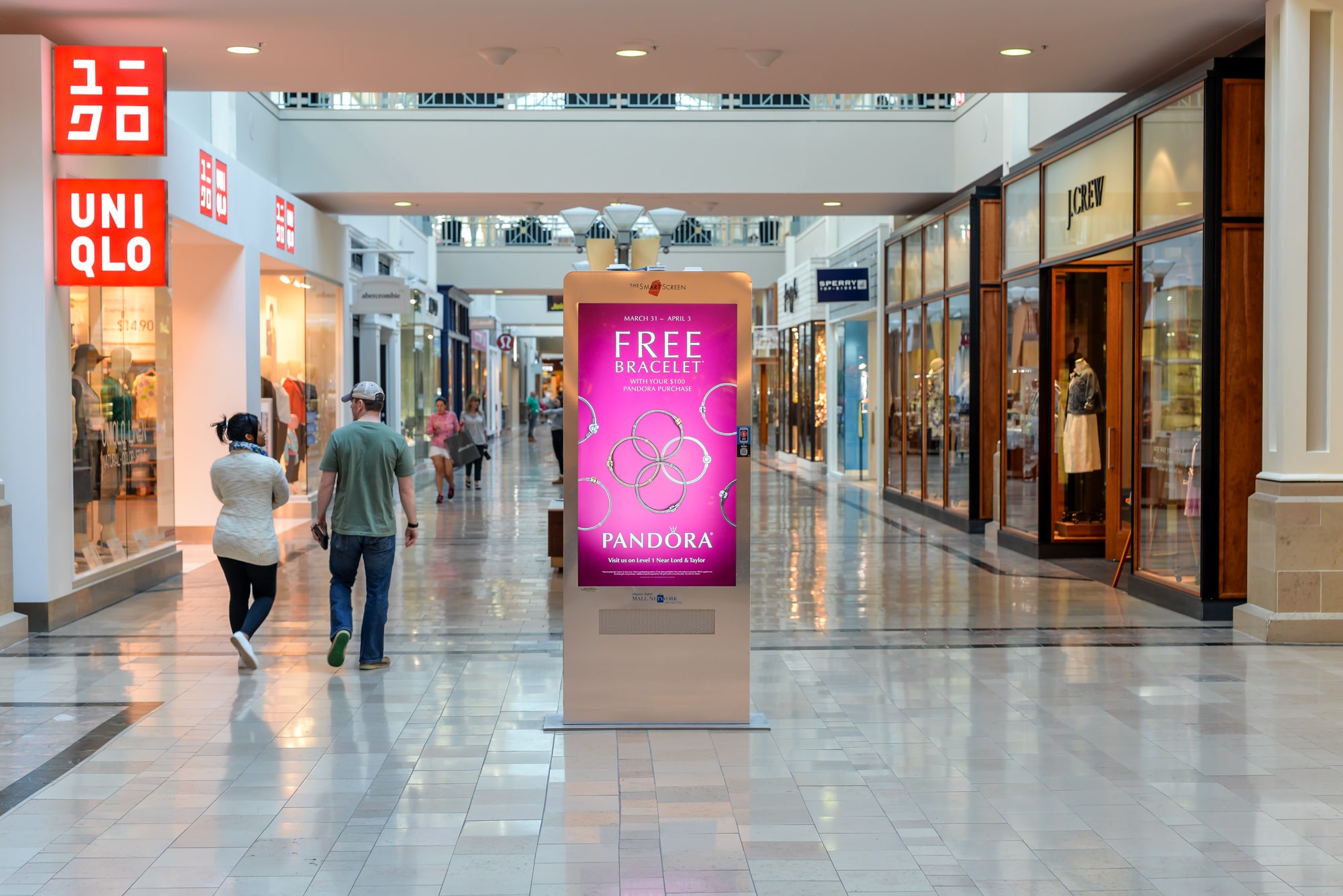Interested in DOOH advertising?
This primer gives you everything you need to know before launching a digital out of home advertising campaign.
What Is Out Of Home Advertising?
Out-of-home advertising (OOH) traces back thousands of years, with the earliest civilizations using it to publicize laws and treaties. The first large-format American poster originated in New York advertising the circus in 1851.
OOH has since expanded to placements on park benches, transit, restaurants, and more. In 2005, the first digital billboards were installed and forever changed OOH advertising.
What Is Digital Billboard Advertising?
Digital out-of-home (DOOH) is a subset of the larger OOH category. This format provides an automated, targeted, dynamic and interactive way to reach on the go consumers in public places.
DOOH ad spend accounts for roughly a quarter of all US OOH spending. Growth can largely be attributed towards an increasingly mobile consumer, which in-turn increases the visibility of out-of-home media.
According to the OAAA, Americans now spend 70% of their time outside of the home, an increase of 50% over the past two decades.
Furthermore, consumers consume 60% of media via their smartphone or tablet on mobile web and apps. This lends to advertisers’ ability to connect with on-the-go audiences across touch points, including DOOH.
Download the full primer below to start leveraging this key advertising channel for your brand today.
What You’ll Learn:
-
- How DOOH advertising is bought and then measured
-
- When you should consider out of home advertising
-
- Digital out of home content strategies and best practices
-
- Available environments and ad inventory
-
- The major players in the industry
If you have any further questions, contact Coegi to learn more!

Digital Out of Home – A Brief History
Out-of-home advertising (OOH) can be traced back thousands of years to early civilizations. The first large-format American poster, measuring 50 square feet, originated in New York advertising the circus in 1851. By 1900, a standard billboard structure was established in America.
With more products entering the market over the century, new and creative ways of reaching consumers became necessary. OOH expanded to park benches, transit, restaurants, etc. In 2005, the first digital billboards were installed, forever changing OOH advertising.
What is Digital-Out-of-Home?
Digital out-of-home (DOOH) is a subset of the larger OOH category. DOOH markets to consumers when they are on the go in public places. Instead of interrupting a user’s online experience with an ad, it meets them in real life. Also, rather than traditional billboards, these placements can be dynamic and interactive.
The Growth of DOOH Advertising
Various eMarketer studies suggest DOOH ad dollars account for roughly a quarter of all OOH spending in the US. Growth is largely attributable to increasingly mobile consumers who are in turn increasing the visibility of OOH media. According to the OAAA, Americans now spend 70% of their time outside of the home. This is an increase of 50% over the past two decades. Plus, consumers consume 60% of media via their smartphone or tablet on mobile web and apps. This lends to advertisers’ ability to connect with on-the-go audiences across touchpoints, including DOOH.

How is DOOH Inventory Bought?
Direct – Sign individual IOs and contracts with OOH vendors to secure space upfront using specific parameters. Space is usually secured on a monthly, quarterly or annual basis.
Open Exchange – Purchase inventory at auction within seconds before the impression is served. The buyer gains control of when and where their ads will be shown. However, publishers reserve some inventory for direct buys. Advertisers can engage in private marketplace deals to secure more premium inventory through programmatic channels.
Private Marketplace – Secure priority access to premium inventory like airports and roadside billboards through private marketplace (PMP) deals. This offers greater control of creative messaging, ad timing and data usage, while still giving publishers higher yields. PMP inventory is typically higher in price than open-exchange inventory.
How to Measure DOOH Campaign Results?
As a one-to-many medium, multiple people can see an OOH ad at once. Nielsen and Geopath provide US industry standards for measuring impressions using variables such as speed data, traffic, on-site counts and audience distribution data.
Geopath does the majority of roadside billboard measurement. Nielsen assigns each type of signage a multiplier based on average views per ad play. If using a DSP, advertisers can use 1×1 tracking pixels to track how many plays an ad receives.
High-Impact Use Cases for Digital-Out-of-Home Advertising
DOOH for Lower-Funnel Campaign Objectives
Programmatic technologies allow for more targeting controls throughout the day. They allow a creative digital media buyer to control spend only when and where a user is most likely to convert.
Examples:
-
- A coffee brand only advertises before 2 pm.
-
- A food delivery app optimizes spend towards areas where drivers aren’t getting rides.
-
- A pharmacy only serves to DMAs where allergy counts are high.
-
- A sports team pauses a campaign when tickets sell out.
DOOH for Targeting Niche B2B Audiences
Many B2B marketers view out-of-home as a mass-market medium, rarely leveraging it outside of industry events. However, with smart use of customer data, planners can confidently buy screens when their niche audience is most likely to see them.
Example: A trade group targeting architects want to geofence a four-day conference in Las Vegas. They can buy the DOOH signage within a radius of the conference and at the airport. Additionally, they can upload attendee data to continue the campaign after the conference to reinforce messaging.
DOOH for Testing Multiple Creative Messages
With static billboards, the same creative often is deployed for 6 or 12 months at a time. Programmatic creative is deployed with an ad server, allowing for more robust creative testing. By pairing this technology with an intelligent measurement strategy, brands can test messaging. Additionally, by porting other data points, creatives can be dynamic and change in real time.
Examples:
-
- A hospital shows current ER wait times
-
- A sports team displays a countdown clock to tip-off
-
- An auto shop displays weather conditions and alerts
How to Design a DOOH Advertisement
You should approach your DOOH content strategy differently than typical display or video campaigns. These placements truly reach people on the go, so you must capture the attention of onlookers immediately and leave them with a memorable message.
Consider these design elements for your DOOH assets:
-
- Loop or slot length (if applicable)
-
- Physical display size
-
- Resolution of display and aspect ratio
-
- Whether or not sound is available
-
- Motion types accepted
-
- File type and maximum size accepted
-
- Video codec type (if applicable)
-
- Capabilities: linear, dynamic, data-driven, real-time optimization, etc
-
- Content restrictions such as adult content, alcohol, violence, drugs, etc.
DOOH ad content should be relevant to both the brand and the display location. Also, make sure the brand name is present and viewable to drive awareness and make the brand connection with viewers.
How to Access Digital Billboard Advertising?
Contact Coegi to get a full list of venues available in your target geo and the accompanying creative specs. Creative opportunities differ by venue and can include static and animated ads, large format ad sizes, sound-off or sound-on creatives and more.
To achieve maximum scale, DOOH advertisers should send creatives that can scale across multiple venues. Your Coegi account team can advise on which venues are best for your audience and goals and provide creative requirements accordingly.
To see DOOH advertising in action, view our case study.
You can also read our DOOH FAQ article with Vistar Media, one of our industry-leading technology partners.





